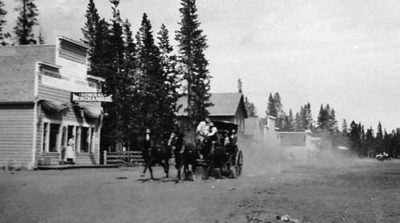From a Confused Identity to Incorporation
With the trains running and businesses open, the town was on its way. While rail construction advanced, workers on the railroad called the future town “Boundary. ” This name reflected its location on the park border. In October 1908, the U.S. Postal Service established a post office here, with the name of Riverside. In 1909, the post office assumed the name of Yellowstone, and so it remained until 1920, when “West” was added. This name change alleviated mail delivery problems due to confusion between the town and the park.
By 1913, over fifty buildings stood on leased Forest Service land among the towering pines. Many of the business owners had difficulty obtaining loans because they did not own their property. Efforts began to remove the site from the National Forest and create an actual town for incorporation. Not everyone was in favor of this move. Some were concerned that without government ownership of the land, “undesirable” enterprises would flourish. Despite this opposition, President Woodrow Wilson signed legislation creating the town in December 1919.
“As you have asked me plainly my opinion regarding this elimination of a tract for townsite purposes, I will say that I do not approve of the same in the least. It will simply be, if not under the control of the government, a row of frontier saloons depending wholly upon our stagedrivers and the soldiers of Yellowstone Park for their patrons. During the past eight or ten years we have had all kinds of grief with Dwelle on account of selling whiskey to our drivers. Dwelle’s place will be within five miles of the station, which is as near by as we care to have a saloon… With saloons at the terminus scarcely a mile distant, and with gambling houses and other resorts that follow, it would seriously interfere with our business and largely increase the danger of accidents to passengers. …this attempt to eliminate certain portions of this reserve for townsite purposes is merely a subterfuge to get the permission to establish saloons at the western entrance… it would be a disgrace to compel visitors from the Oregon Short Line to be confronted with this sort of a proposition the moment they step from the train.”
-Excerpts from a December 30, 1907 letter from F.J. Haynes, owner of the Monida & Yellowstone Stage Line, St. Paul, MN, to Mr. R.A. Sherman, Chief Inspector, United States Department of Agriculture, Missoula, MT
In 1915, the doors to the town’s first school opened. Two young students were enrolled to meet the state’s minimum number required for a separate school. This school was First through Eighth Grade only, as there were too few students to warrant a high school. By the mid-1920s, a larger school was built, although it remained 1-8 only. Families with high school age students had to take them elsewhere until 1967, when the teenage population finally reached sufficient numbers to justify a high school. The first West Yellowstone High School senior class graduated in 1968.
The town made a significant stride when it achieved incorporation on June 6, 1966, nearly 47 years after the town was removed from the national forest. Now the residents had more power over their destiny, as they were able to make many decisions locally that Gallatin County had previously controlled. Incorporation made it possible to allow over-the snow travel on city streets which was important for the burgeoning snowmobile recreation activities that brought wintertime trade. The town’s first bank, First Security, opened for business the same day the town was incorporated.
Now West Yellowstone had everything it needed to be a real town: a name, a post office, private land, a school, incorporation, and a bank!


